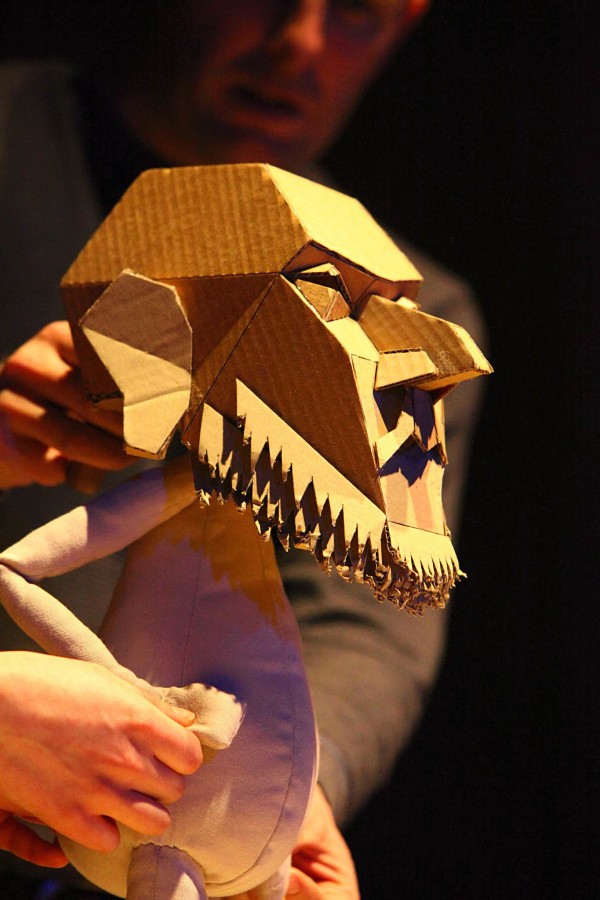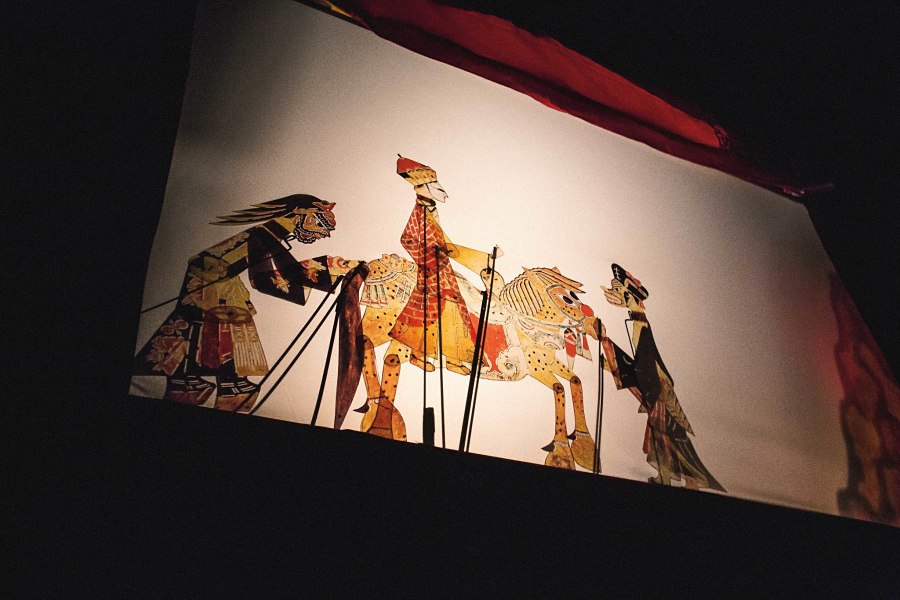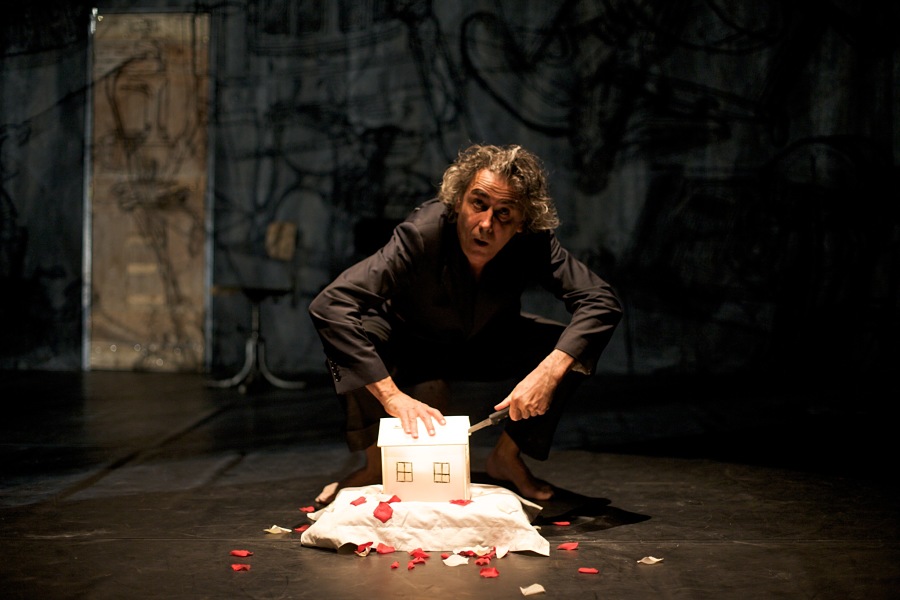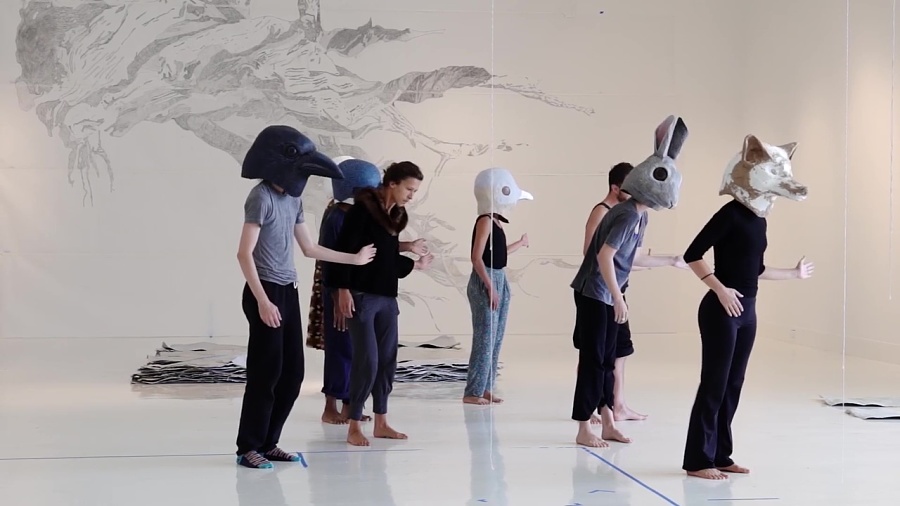As today’s cutting-edge puppeteers peer into the souls of animated objects, they’re seeing the future—or rather, the eternal present—of the theatre.
by Scott T. Cummings
According to Moses, the cocky cardboard hero of The Table, a production by the inventive London-based puppetry company Blind Summit Theatre, there are three commandments of puppetry:
1) Focus guides the audience to see things that are not there, 2) Breathing is the key to convincing manipulation, and 3) A fixed point gives the figure a realistic sense of weight.
Is that so, Moses? The self-described “funny little puppet on a table” discusses these trade secrets as part of a 75-minute performance that is part stand-up comedy, part lecture/demonstration and part Bible story about the Old Testament’s sea-parting prophet and the last lonely hours of his life atop Mount Nebo. What began five years ago as part of an alternative Passover observance at the Jewish Community Centre in London has become a hit wherever Blind Summit and its artistic director, Mark Down, take it.

The metatheatricality of The Table—a puppet show about puppets—is emblematic of a current fascination. Puppets are everywhere these days: on Broadway, in Hollywood movies and television advertising, at the spectacles that open the Olympics. Playwrights, from Sarah Ruhl in The Oldest Boy to Robert Askins in Hand to God, write them into their plays as characters. They turn up more and more in opera. Late-night puppet slams are cropping up around the country. We live in what Claudia Orenstein of Hunter College calls “a puppet moment,” a time of sustained cultural interest in animated objects as a form of artistic expression and a tool of commerce and mass entertainment.
Puppets are also a hot topic for serious academic investigation. Orenstein, Dassia N. Posner and John Bell are the editors of the new Routledge Companion to Puppetry and Material Performance, a 2014 volume of wide-ranging essays aiming to set the agenda for puppet scholarship for the next generation. Influenced by contemporary “thing theory” and object-oriented ontology, the book argues for a paradigm shift from the idea of the master puppeteer pulling all the strings to a view of puppets as having their own life and agency. If we will only listen, the reasoning goes, puppets have things to tell us about what it means to be a person and what it means to be an object.
In mainstream theatre, the current “puppet moment” might be traced back to 1997 and Julie Taymor’s historic production of The Lion King, which, with well over $6 billion in revenues, is now the most successful single show in the history of box-office entertainment. Avenue Q and War Horse have kept puppets in the spotlight, and King Kong, a blockbuster musical from Australia featuring a 20-foot ape, is reportedly getting ready to take Manhattan.
Are puppets on Broadway simply the novelty du jour? Or are they signs of a marginalized performance practice coming into its own as an art form? Is the expanding sense of what constitutes a puppet confusing the matter or opening up new possibilities for creativity and experiment?
To gain some perspective on these questions, I traveled to two festivals earlier this year—the first-ever Chicago International Puppet Theater Festival and Puppet Animation Scotland’s creatively titled Manipulate: Visual Theatre Festival #8 in Edinburgh.
Festivals are crucial to the survival of puppet theatre companies, particularly those with an interest in creating serious work for adult audiences. Not only a source of income, they also provide a showcase where presenters can shop for new work and artists can exchange ideas and learn from each other. The biennial Festival Mondial des Théâtres de Marionnettes in Charleville-Mézières, France, is perhaps the most important, but there are dozens more each year, mainly in Europe (such as the Puppet is a Human too Festival in Warsaw, or the Suspense Puppetry Festival, presented by London’s Little Angel Theatre). In New York City in the 1990s, the Henson International Festival of Puppet Theater was a revelation to American practitioners and general audiences, but since the fifth and final Henson festival in 2000, the U.S. has lacked a major international puppet theatre festival.
Blair Thomas has set out to change that. A Chicago theatre artist for 30 years and artistic director of his own company since 2002, Thomas saw how the international work at the Henson festivals inspired the American puppet community. He also experienced how, from 1986 to 1996, the biennial International Theatre Festival of Chicago “changed what theatre artists in Chicago were doing,” including Thomas himself (whose response to the 1988 Windy City appearance of Barcelona’s Comediants was to found Redmoon Theater with choreographer Laurie Macklin).
Thomas figures that if he can establish an international puppet festival that becomes an institutional presence in Chicago, then the art form may be advanced around the country. And if in the process Chicago becomes the puppet capital of the U.S., so much the better.
Thomas’s strategy for launching the festival was as simple as it was ambitious. “Chicago is the city that collaborates,” he likes to say, so he began pitching the idea to area institutions large and small—theatres, museums, universities and other presenters—that already had an established interest in puppets, experimental theatre or community-based arts. The idea was to assemble a coalition of organizations, each of which would produce one or more events in keeping with their regular programming but under the festival banner. So the educational center of the Art Institute could contribute a family-oriented day of workshops and puppet shows tied to their major James Ensor exhibit; the madcap Neo-Futurists could host the equally zany David Commander and his toy-theatre cast of action figures, Barbie dolls and plastic animals; Chicago Shakespeare Theater could bring back Blind Summit (after a successful visit in 2013); and Chicago Children’s Theatre could revive Blair Thomas and Michael Smith’s popular 2008 adaptation of Oscar Wilde’s The Selfish Giant. In this way, one festival would serve multiple constituencies.
Thomas recruited Claire Geall Sutton, a veteran of the city’s Department of Cultural Affairs and a key organizer for a 2001 citywide event called Puppetropolis, to come on board as managing director. The imprimatur of a generous lead grant from the MacArthur Foundation emboldened organizers to forge ahead and reach out to more funders and presenters.
Chicago’s packed cultural calendar in warmer months prompted the decision to schedule the festival in January and risk the hassle of a winter storm. In the end, the weather was cooperative, and over 12 temperate days without rain or snow, the inaugural Chicago International Puppet Theater Festival presented more than 50 artists and 80 events—most of them sold out—for a total audience of more than 14,000.
The shows in Chicago ranged from the kind of traditional, family-friendly work often seen at schools, libraries and public fairs to edgy, experimental performances more common to galleries, lofts and tiny black-box theatres. Veteran Dave Herzog presented cute, colorful, well-crafted trick marionettes that can juggle, blow up a balloon, swing on a trapeze, or instantly transform from a magician into a fairy. His circus figures contrasted with the mesmerizing Le Petit Cirque of Laurent Bigot from France, who uses a table-top toy circus reminiscent of Alexander Calder, rigged with 16 tiny microphones to perform a concert of odd, cleverly generated sounds. New York’s Chinese Theatre Works (inspired by the pioneering work of Kansas-born Pauline Benton, who brought Chinese shadow puppetry to the West in the 1920s) performed a traditional Chinese shadow-puppet play in the halls of the Field Museum. Contrast this with the innovative shadow theatre of Chicago’s own Manual Cinema (see our sidebar feature) or Canadian artist-illustrator Daniel Barrow, both of whom use multiple overhead projectors (in very different ways) to create manual animation in real time.

The variety of work programmed by Thomas points to a question that is fascinating artists, audiences, and academics: What constitutes a puppet, exactly? What, in other words, is its nature and essence? How does it help us to explore and understand the larger world of what cultural anthropologist and folklorist Frank Proschan dubbed “performing objects”—puppets, masks, ritual and fetish objects, and other material things endowed with agency through display, manipulation, storytelling, or performance?
No one in the U.S. has done more to instigate consideration of such questions than artist, activist and scholar John Bell, a 10-year veteran of Bread and Puppet Theater, a founding member of the theatre collective Great Small Works, and director of the Ballard Institute and Museum of Puppetry at the University of Connecticut. Bell takes issue with those who regard puppets as quaint, primitive or outmoded, arguing that a wide array of forms and practices should be seen and studied as puppetry.
“If a performance is mediated by focus on an object and its manipulation,” Bell says, “then to my mind it is in the realm of the puppet.” The youthful giants constructed by Royal de Luxe in the shipyards of Nantes, Frances, the fabric “crankies” used by the Appalachian folk duo Anna & Elizabeth to illustrate their songs, even the eight large panels made by street artist JR and carried side-by-side by New York protest marchers to create the eyes of chokehold victim Eric Garner—all need to be seen as puppets. For Bell, it’s not a matter of fussing about nomenclature but of taking the opportunity to better to understand contemporary culture and its values, preoccupations and actions by looking at them in the wider context of the history of performing objects.
Blair Thomas sees this kind of serious thinking as crucial to the advancement of puppetry. “Nothing becomes really important unless there are ideas behind it,” he argues. “This is what I learned from working in spectacle—spectacle can be fantastic experientially, but it has to be embedded with social, historical or political ideas. It has to have relevance, so that people outside of the form have a way to enter into it.”
And so, as part of the festival, he teamed with curator and stage director Leslie Buxbaum Danzig and the University of Chicago’s Richard and Mary L. Gray Center for Arts and Inquiry to launch the Volkenburg Puppetry Symposium, a day of “unexpected conversations” at the Museum of Contemporary Art Chicago between performing artists and thinkers in other disciplines.
One of those conversations focused on the peculiar ways in which puppets fluctuate between the animate and the inanimate—or, metaphorically, between life and death. Blind Summit’s Mark Down, lead operator and voice of the puppet Moses in The Table, pointed out that “it is not puppeteers who make puppets come alive. The puppet lives in the audience’s imagination. We try to steer that, and perhaps persuade it to go somewhere exciting, but to be honest we don’t have a huge amount of control over it.”
Dan Hurlin, creator of such stunning puppet works as Hiroshima Maiden and Disfarmer, extended the thought by suggesting that spectators may “identify more with puppets than live actors, because they are more of a participant in pretending they are dead or alive. No matter how great the performance, there is always a part of you that knows that at the end of the show the actor is going to go out and have a beer or a glass of wine and then go home to bed. Puppets don’t do that. They only exist in the present of performance. And that makes them agents of presence.”
For the past decade in Edinburgh, Simon Hart has been pursuing a mission similar to the one adopted by Blair Thomas in Chicago. Hart is artistic director and CEO of Puppet Animation Scotland, an arts organization that produces two different festivals on an annual basis. One is a series of puppet shows and workshops for children and families that tour to village halls and community centers all over Scotland. Started in 1984, it has grown into the largest performing arts event for children in the United Kingdom. The other is Manipulate, the international visual theatre and animation festival for adult audiences that he launched in 2008 in an effort to nurture, promote and otherwise instigate visual theatre culture in Scotland.
“When we started,” Hart explains, “there were two ideas: first, to bring great international work to Scotland and find an audience for it; and second, through this work and our master-class program, to encourage Scottish artists to create work of a similar scale and ambition, which ideally would go back and tour internationally.”
The first Manipulate, which took place in Dundee, presented four companies whose work staked out Hart’s territory of interest: Belgium’s Compagnie Mossoux-Bonté, France’s Vélo Théâtre, Holland’sDuda Paiva, and English marionettist Stephen Mottram. Says Hart, “The dominance of the spoken word in theatre from Shakespeare on is so incredibly powerful” that much of this type of work “never gets to the U.K., let alone to Scotland.” The festival shifted to Edinburgh in 2009, and since then it has been based at the Traverse Theatre, which provides facilities, ticketing services, technical staff and “enthusiastic partnership” in exchange for a piece of the box office.

Over the years, the four original companies have been joined by Austria’s Editta Braun Company, Germany’s Figurentheater Tübingen, Neville Tranter’s Stuffed Puppet Theatre from Amsterdam, and London’s 1927. In 2014, Joyce McMillan, longtime theatre critic for The Scotsman, called Manipulate “one of the unsung small miracles of the Scottish cultural scene.”
Manipulate is expressly a “visual theatre festival” with a strong but not exclusive interest in puppets and animation—the 2015 event included three-day professional workshops on contemporary shadow theatre by Italian master Fabrizio Montecchi and on working with objects by Polina Borisova from Russia. There was also a screening of short puppet-animation films by Claire Lamond and a “Snapshots” series that showcased excerpts from traditional puppet works in progress. Strictly speaking, the only featured work of puppet theatre in 2015 was Autumn Portraits from Vermont’s Sandglass Theater (see our sidebar feature), but there were solo dance pieces from Belgium’s Sandman/Sabine Molenaar and the Czech Republic’s Andrea Miltnerová, both of which transformed the dancers’ bodies into abstract forms driven by unseen forces. U.S.-based Paper Doll Militia and Edinburgh’s All or Nothing each performed aerial dance-theatre pieces.
The most satisfying entries came from two well-established European companies whose work has been described as “theatre of objects.” Each combined elements of puppetry, material performance, toy theatre, shadow play, physical comedy, music and design into highly theatrical shows loosely based on mythic narrative. Vélo Théâtre, based in the south of France, performed And Then He Ate Me, a lyrical deconstruction of the Little Red Riding Hood tale refracted through the prism of Büchner’s drama Woyzeck. The wild men of Theatre AKHE, a performance collective from St. Petersburg, performed Mr. Carmen, in which two deadpan, whiteface clowns with scruffy beards wreak havoc as they compete for more and more astonishing ways to write out the names Carmen and José (from Mérimée via Bizet) onstage.
Hart created Manipulate so that Scottish audiences could experience a type of European theatre driven more by images, objects and movement than by text, character and plot—theatre that leaves a lot of room, he says, “for the individual audience members to join the dots in a way that is satisfying to them, and to interpret something in a way that may be radically different from the person beside them.” In an American context, this aesthetic can be traced back to the avant-garde impulses of Meredith Monk, Robert Wilson, Richard Foreman, and others once categorized by Bonnie Marranca as “theatre of images” and more recently designated “postdramatic theatre” by Hans-Thies Lehmann and others. The implicit argument of Manipulate is that puppets are a valuable element of this experimental tradition—witness the work of Lee Breuer and Mabou Mines, from Shaggy Dog Animation (1978) to La Divina Caricatura (2013)—but are not essential to it.
Many of the artists featured in a special section on puppets in the February ’04 issue of this magazine—Basil Twist, Janie Geiser, Dan Hurlin, Erik Ehn, Jon Ludwig, Sandy Spieler—are still, more than a decade later, among the leading figures in the field. Whether that is a sign of stability or stagnation in the American puppetry movement is a matter for debate. Chicago’s Manual Cinema is on the rise, and Jessica Grindstaff and Erik Sanko’s New York City–based Phantom Limb Company premiered Memory Rings in June in Nashville, but there is ample room in the national spotlight for a younger generation of puppet artists pushing the form in new directions.

Some of them, we can hope, will come through the training programs led by Bart P. Roccoberton Jr. at the University of Connecticut and Janie Geiser at CalArts. In New York City, the Dream Music puppetry program at the performance space HERE and the Puppet Lab at St. Ann’s Warehouse continue to nurture emerging artists and incubate new work. And this June marks the 25th anniversary of the National Puppetry Conference at Connecticut’s Eugene O’Neill Theater Center as a mecca for training and experimentation; the 2015 conference features workshops in writing for puppets (Ronnie Burkett), experimental puppetry (Alice Therese Gottschalk), the body as puppet (Hugo & Ines), puppet mechanics (Jim Kroupa) and marionette design, construction and manipulation (Phillip Huber and Jim Rose).
In 2004, Twist argued in these pages for puppetry as its own art, “a form of creative expression, distinct from theatre and dance, music and visual art, storytelling and poetry.” And he continues to pursue his vision of pure puppetry, most recently in the swirling, dancing fabrics he deployed in his response to Stravinsky’s Rite of Spring. But more and more, performing objects, figurative or abstract, are being integrated with these other forms to generate new hybrid possibilities. And different types of puppets—bunraku-style figures, marionettes, shadow puppets, toy figures, giant puppets, animation—are often found in a single work. As Thomas says, “Puppetry today is a mashup of work. The field has such plurality. And audiences love that.”
Scott T. Cummings, professor of theatre at Boston College, is a scholar of contemporary theatre.
View article online.